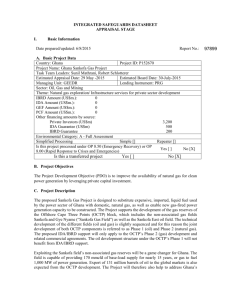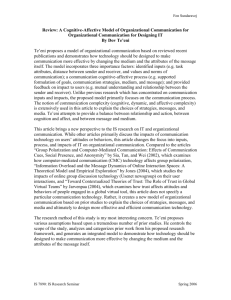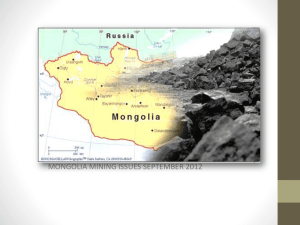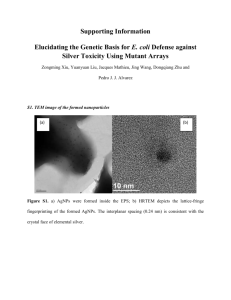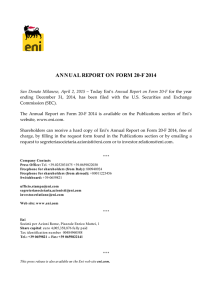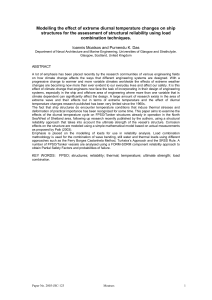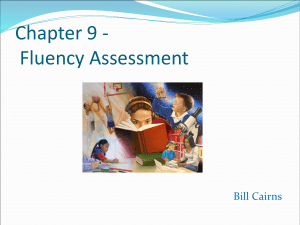Integrated Safeguards Data Sheet - Documents & Reports
advertisement
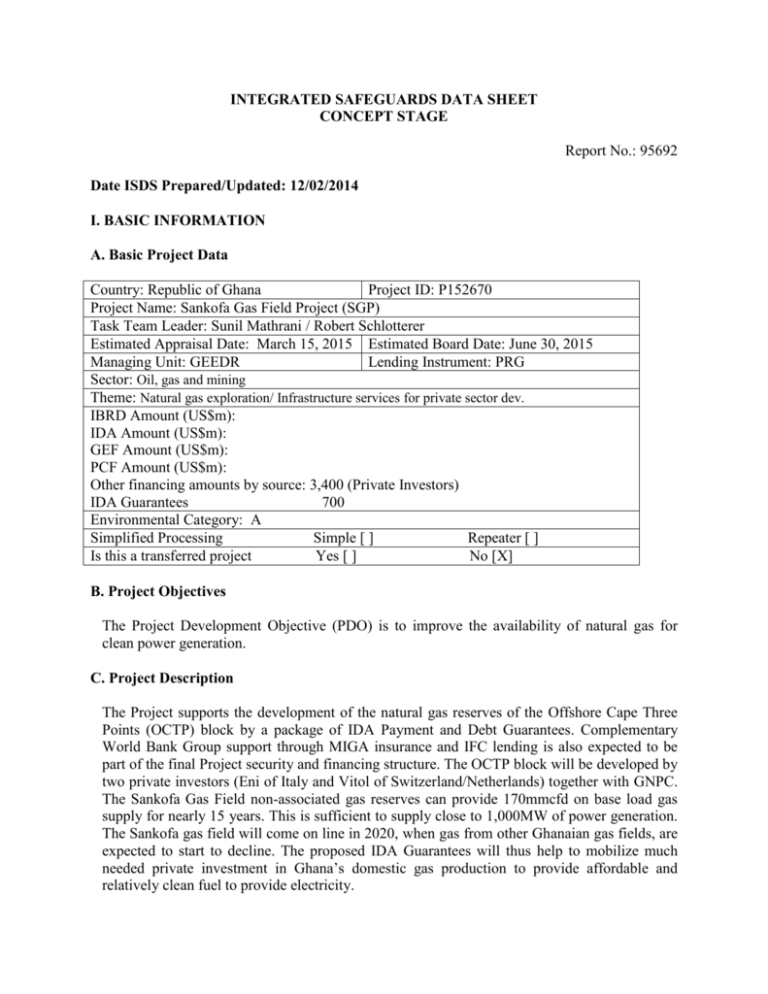
INTEGRATED SAFEGUARDS DATA SHEET CONCEPT STAGE Report No.: 95692 Date ISDS Prepared/Updated: 12/02/2014 I. BASIC INFORMATION A. Basic Project Data Country: Republic of Ghana Project ID: P152670 Project Name: Sankofa Gas Field Project (SGP) Task Team Leader: Sunil Mathrani / Robert Schlotterer Estimated Appraisal Date: March 15, 2015 Estimated Board Date: June 30, 2015 Managing Unit: GEEDR Lending Instrument: PRG Sector: Oil, gas and mining Theme: Natural gas exploration/ Infrastructure services for private sector dev. IBRD Amount (US$m): IDA Amount (US$m): GEF Amount (US$m): PCF Amount (US$m): Other financing amounts by source: 3,400 (Private Investors) IDA Guarantees 700 Environmental Category: A Simplified Processing Simple [ ] Repeater [ ] Is this a transferred project Yes [ ] No [X] B. Project Objectives The Project Development Objective (PDO) is to improve the availability of natural gas for clean power generation. C. Project Description The Project supports the development of the natural gas reserves of the Offshore Cape Three Points (OCTP) block by a package of IDA Payment and Debt Guarantees. Complementary World Bank Group support through MIGA insurance and IFC lending is also expected to be part of the final Project security and financing structure. The OCTP block will be developed by two private investors (Eni of Italy and Vitol of Switzerland/Netherlands) together with GNPC. The Sankofa Gas Field non-associated gas reserves can provide 170mmcfd on base load gas supply for nearly 15 years. This is sufficient to supply close to 1,000MW of power generation. The Sankofa gas field will come on line in 2020, when gas from other Ghanaian gas fields, are expected to start to decline. The proposed IDA Guarantees will thus help to mobilize much needed private investment in Ghana’s domestic gas production to provide affordable and relatively clean fuel to provide electricity. The Sankofa and Gye Nyame gas fields (“Sankofa Gas Field”) and the Sankofa East oil field, are located 60km offshore in the Western Region of Ghana. The Sankofa Gas Field is part of the OCTP block, together with the Sankofa East oil field. The OCTP will be developed in two phases. Phase 1 of the OCTP encompasses the development of the Sankofa oil field and Phase 2 caters for the development of non-associated gas in the Sankofa Gas Field. IDA Guarantee support proposed hereunder would only relate to the OCTP's Phase 2 development. The oil development structure under the OCTP Phase 1 will not benefit from IDA Guarantee support. D. Project location and salient physical characteristics relevant to the analysis of environmental and social risks and impacts (if known): The Sankofa Gas Field is in the Gulf of Guinea, at a depth of about 1,000m, approximately 60 km south of the Ghanaian coastal community of Atuabo. Gas will be transmitted from the FPSO via a 63-km undersea pipeline that makes its landfall slightly to the west of the community of Sanzule, in the Western Region of Ghana. From the landing point, a pipeline of approximately 800 m will convey the gas to the Onshore Receiving Facility (ORF) for compression. A short pipeline will carry the compressed gas to the GNGC pipeline, adjacent to the ORF site to the north. The locations of the additional compression stations mentioned in the project description are not yet known, but at the one required for interconnection with the GNGC pipeline, and possibly both, would be considered associated facilities that would need to be included in the safeguards arrangements for the project. With the exception of small patches of swamp forest and wet evergreen forest, the forest that may once have been on the ORF site has been disturbed by human activity -- mainly plantations of cassava, pineapple, coconut and oil palm. A small tributary to the Amansuri River crosses the site from west to east near the shore and may have scattered mangroves. There are dense mangroves along this tributary but further downstream, off the proposed site. The beach crossing itself will be challenging, because the shoreline is rock with a relatively thin layer of sand. Coastal erosion is a problem in the area, and depending on how the pipeline is installed, it could aggravate the erosion. Endangered sea turtles and various marine mammals including whales frequent the Gulf of Guinea, which is also an important resource for artisanal and commercial fisherfolk. Sea turtles use the Ghanaian beaches for nesting; whether the location of the pipeline landfall is a nesting area will have to be determined in the ESIA. There are no living coral reefs in the project-affected area. AAt least three villages – Sanzule, Bakanta, and Krisan – are close enough to the proposed location to be at some risk in the event of an accident resulting in explosion or fire at the ORF. Acquisition of land for the project will affect the livelihoods of 202 persons, 166 of whom are farmers. There are 21 structures on the land; 13 of them are residential, most of them simple houses on the beach used by migrant fishermen with permission of the village chief. There are 264 farm plots to be acquired, and 51 aquaculture ponds. The presence of shrines and other sacred places has been confirmed. . E. Borrower’s Institutional Capacity for Effective SEMS: Eni has a well-established corporate Health, Safety and Environment (HSE) Policy endorsed by its Managing Director and applicable to all operations of the company and to its contractors and subcontractors. The HSE Policy and the Operation Controls that are associated with it have been developed and are implemented in accordance with ISO 14001 Environmental Management System specifications. Eni also has an in-house Environmental, Social and Health Impact Assessment Standard that is aligned with international best practice. The Eni project team will include an environmental advisor and an environmental lead, both reporting to the resident engineer. F. Environmental and Social Safeguards Specialists on the Team: Thomas Walton, Consultant – Environmental Specialist Demba Balde-- Social Safeguards Specialist II. PERFORMANCE STANDARDS THAT MIGHT APPLY Performance Standards (please explain why) Yes No TBD PS 1: Assessment and Management of Environmental X and Social Risks and Impacts The project has been categorized as Category A, requiring a full ESIA, and meets the criteria in OP 4.03 for application of the Performance Standards. Ghana EPA is also requiring a full ESIA. Eni has already prepared a separate ESIA for OCTP Phase 1 that is about to be submitted to EPA for review. The ESIA for Phase 2 (SPG) will include the FPSO, since it is a shared facility, and will address the other impacts of Phase 1 as part of the cumulative assessment. One or both of the additional compressor stations GNPC will need to utilize the gas will be covered in the ESIA as associated facilities. Drilling operations, laying of the undersea pipeline, installing the beach crossing, installing the pipeline from the beach to the ORF (which involves a river crossing and disturbance of some wet evergreen forest mixed with coconut palms), and clearing the locations for the ORF, base camp and helipad are the main sources of potential environmental impact during construction. During operation, the most significant event that could affect the marine and coastal environments is a crude oil spill from the FPSO, which handles oil and associated gas from the OCTP Phase 1 as well as non-associated gas from SGP, or from the rupture of a flow line from an oil well to the FPSO. Possible accidents involving gas leaks, fire or explosion at the FPSO or the ORF or its pipelines are also concerns. Management of drilling wastes and cuttings, solid waste and hazardous waste, air emissions and noise will be important. Aspects of the natural and human environments that could be impacted are: air quality, marine water quality, surface and groundwater quality at the ORF site, coastal erosion, noise levels at the FPSO, ORF, and drilling rigs, occupational health and safety, aquatic/benthic life disturbance (fishes, marine mammals and turtles), community health and safety, livelihoods from farming and fishing activities, and disturbance of cultural heritage. PS 2: Labor and Working Conditions X Any facilities involving gas require meticulous attention to workplace safety and, in Africa there must be provisions to protect facilities and personnel from criminal activities that have affected offshore oil and gas operations, particularly in Nigeria, including piracy, attacks on and occupation of facilities, hostage-taking, and theft of oil. The ESIA will include a review of relevant Ghanaian workplace and labor legislation (e.g., the Factories Act) as well as a review of Eni human resources management policies and procedures. The ESMP will include appropriate recommendations for incorporation into the ESMS. Performance Standards (please explain why) Yes No TBD PS 3: Resource Efficiency and Pollution Prevention X Pollution prevention and response to accidents involving pollutant releases will be central concerns in the ESIA. Spill prevention plans and emergency response plans will be prepared in association with the ESIA. Since part of the project is located in the sea, all applicable conventions addressing marine pollution will be taken into account. WBG EHS Guidelines and good international industry practices will serve as references for development of the ESMP. PS 4: Community Health, Safety, and Security X Emergency Response Plans will need to be prepared and the potentially affected communities will need to be made aware of them. Security arrangements to protect the FPSO and to keep ships and fishing boats out of the restricted area need to be carefully planned, implemented and supervised to minimize conflict with fisher folk and other users of Gulf of Guinea waters. PS 5: Land Acquisition and Involuntary Resettlement X Eni is acquiring the land through voluntary sale after direct negotiation with owners rather than expropriation. However given the complexity of land ownership in Ghana, the large number of farmers who are not the actual owners but use the land under various traditional arrangements with the owners, and the presence of migrant fishermen who have only informal rights to occupy homes on the beach, it is sensible to apply PS5. Eni has already begun drafting a Resettlement Action Plan, following the guidelines in OP 4.12. PS 6: Biodiversity Conservation and Sustainable X Management of Living Natural Resources The amount of habitat on the proposed ORF site that could be considered natural rather than already converted or, at best, modified, is small and should be avoidable in project design. The marine and coastal waters and their ecosystems provide habitat for fish of importance to local livelihoods and the economy as well as habitat for endangered sea turtle species and for marine mammals, some of which are endangered. Key issues to be addressed in the ESIA will be: prevention of pollution that could affect marine life or, via the tributary on site, the ecology of the Amansuri Estuary, and avoidance of disturbance to sea turtle nesting. Careful monitoring to assess the effectiveness of mitigation measures and detect unforeseen impacts will be important. PS 7: Indigenous Peoples X No groups that meet the definition in PS7 have been identified in the project area. PS 8: Cultural Heritage X Preliminary investigations have determined that there is one deity that occupies two sacred locations on the project site and may need to be resettled, with appropriate ceremonies. There are shrines on some of the properties that will be acquired. OP 7.50: Projects on International Waterways X The Gulf of Guinea is an international waterway. Riparian countries will need to be notified of the proposal to proceed with SGP. Notification can be most efficiently done via Ghana’s representative on the Gulf of Guinea Commission. III. SAFEGUARDS PREPARATION PLAN A. Target date for the Quality Enhancement Review (QER), at which time the ESRS would be disclosed and the PAD-stage ISDS would be prepared: February 3, 2015. B. For Category C or Category FI projects that do not require an ESRS, the target date for preparing the PAD-stage ISDS: NA C. Time frame for launching and completing the safeguard-related studies that may be needed. The specific studies and their timing1 should be specified in the PAD-stage ISDS: Eni’s consultant is beginning the scoping stage of the ESIA on December 1, 2014. All baseline surveys will have been completed by December 31, 2014. An ESIA report suitable for disclosure is anticipated in February 2015. The RAP will be finished and disclosed at the same time, if not before. IV. APPROVALS Signed and submitted by: Task Team Leader: Approved by: Regional Safeguards Coordinator: Comments: Sector Manager: Comments: 1 Name: Sunil Mathrani Date Name: Alexandra Bezeredi Date Name: Meike van Ginneken Date Reminder: The Bank's Access to Information Policy requires that safeguard-related documents be disclosed before appraisal (i) at the InfoShop and (ii) in-country, at publicly accessible locations and in a form and language that are accessible to potentially affected persons.
